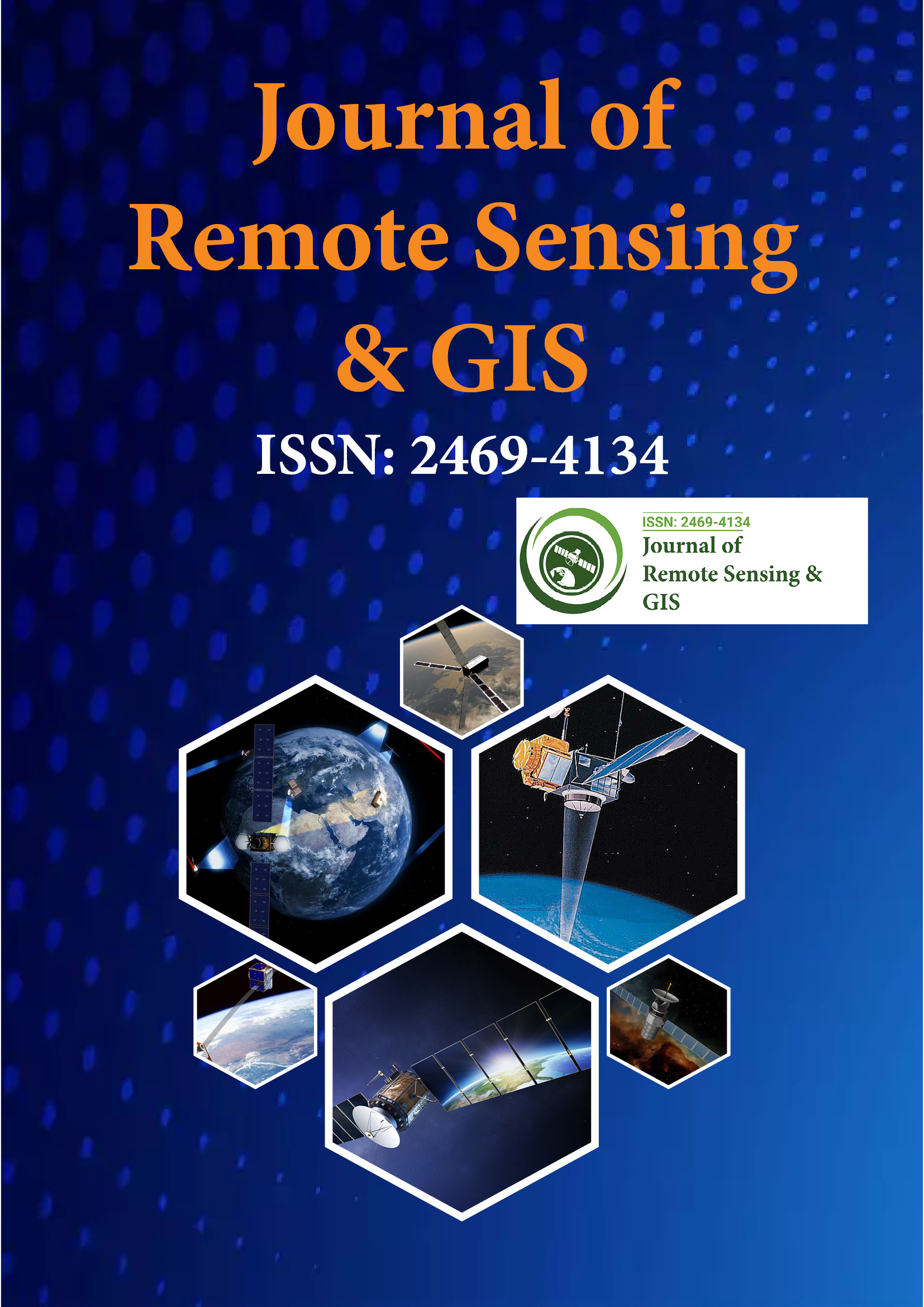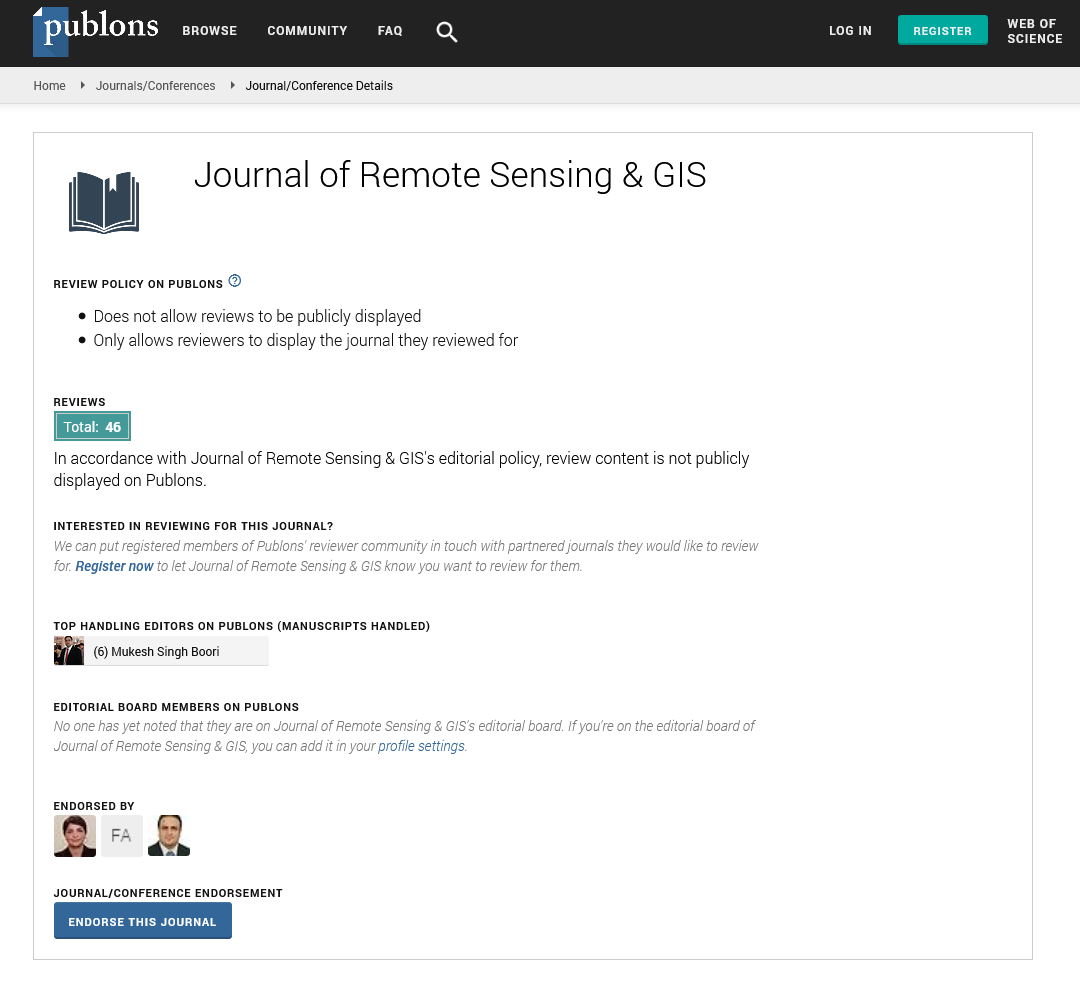Indexed In
- Open J Gate
- RefSeek
- Hamdard University
- EBSCO A-Z
- OCLC- WorldCat
- Publons
- International Scientific Indexing
- Euro Pub
- Google Scholar
Useful Links
Share This Page
Journal Flyer

Open Access Journals
- Agri and Aquaculture
- Biochemistry
- Bioinformatics & Systems Biology
- Business & Management
- Chemistry
- Clinical Sciences
- Engineering
- Food & Nutrition
- General Science
- Genetics & Molecular Biology
- Immunology & Microbiology
- Medical Sciences
- Neuroscience & Psychology
- Nursing & Health Care
- Pharmaceutical Sciences
Perspective - (2024) Volume 13, Issue 4
Remote Sensing for Biodiversity: Innovations in Ecosystem Monitoring and Management
Fahmi Naim*Received: 25-Nov-2024, Manuscript No. JGRS-24-28063; Editor assigned: 27-Nov-2024, Pre QC No. JGRS-24-28063 (PQ); Reviewed: 12-Dec-2024, QC No. JGRS-24-28063; Revised: 20-Dec-2024, Manuscript No. JGRS-24-28063 (R); Published: 27-Dec-2024, DOI: 10.35248/2469-4134.24.13.363
Description
Biodiversity and ecosystem health are fundamental to sustaining life on Earth. The increasing pressures of climate change, habitat loss and human activities necessitate effective monitoring systems to assess and manage ecological changes Remote sensing allows for detailed observation and analysis of land cover and habitat changes across spatial and temporal scales. Satellite imagery and aerial photography offer a bird's-eye view of landscapes, enabling the identification of deforestation, urban encroachment and land degradation. For example, multispectral and hyperspectral sensors can distinguish between vegetation types and assess their health, aiding in habitat classification and tracking changes over time.
By mapping changes in forest cover or wetland areas, researchers can identify trends that threaten biodiversity. Such data play a key role in conservation planning, helping policymakers prioritize regions for protection or restoration. For example, the use of Landsat and Sentinel satellite data has been instrumental in tracking deforestation in the Amazon and evaluating its impacts on species richness.
Species distribution and abundance estimation
Remote sensing contributes to understanding species distribution by mapping habitats and modeling ecological niches. Habitat suitability models, when integrated with remote sensing data, provide insights into areas likely to support specific species. For instance, combining remote sensing with ground based observations enables the prediction of bird or mammal distributions in diverse ecosystems.
Advanced technologies like LiDAR (Light Detection and Ranging) create three-dimensional maps of vegetation structure, offering insights into habitat complexity. This information is particularly useful for studying species that depend on specific vegetation strata, such as canopy-dwelling primates or understory birds. High-resolution imagery from drones further enhances the precision of species monitoring, particularly in remote or inaccessible regions.
Assessing ecosystem functions and services
Remote sensing aids in evaluating ecosystem functions, such as carbon sequestration, water cycling and primary productivity. Vegetation indices like the Normalized Difference Vegetation Index (NDVI) are widely used to estimate plant health and productivity. Similarly, thermal sensors measure land surface temperature, providing insights into water stress and heat island effects.
By quantifying these functions, remote sensing supports the assessment of ecosystem services that benefit human societies. For example, monitoring mangrove forests which provide coastal protection and carbon storage requires accurate mapping of their extent and health. Remote sensing offers a scalable solution for such assessments, guiding sustainable management practices.
Tracking climate impacts on biodiversity
Climate change poses significant threats to biodiversity and ecosystems, including shifts in species ranges and changes in phenological events. Remote sensing provides data to monitor these impacts effectively. Seasonal variations in vegetation, for instance, can be tracked using time-series satellite imagery to understand how climate variability affects ecosystems.
Polar regions, where climate change effects are most pronounced, benefit greatly from remote sensing technologies. Satellite data have revealed shrinking ice cover, changing tundra vegetation and altered wildlife migration patterns. Such information is invaluable for predicting future changes and guiding adaptive strategies to mitigate impacts on biodiversity.
Detecting invasive species
Invasive species disrupt native ecosystems and threaten biodiversity. Remote sensing offers innovative ways to detect and monitor these species. For example, hyperspectral imaging can differentiate invasive plants from native vegetation based on their spectral signatures. This capability enables early detection, allowing for timely intervention to control invasions.
Additionally, remote sensing assists in monitoring the spread of aquatic invasive species by capturing changes in water quality and vegetation in aquatic habitats. Such data can inform management strategies to protect native species and maintain ecosystem balance.
Biodiversity hotspots and conservation priorities
Identifying biodiversity hotspots and areas of conservation priority is a significant application of remote sensing. High resolution satellite images and spatial analysis tools enable the mapping of regions rich in species diversity and endemism. By overlaying biodiversity data with human impact metrics, such as roads or urban development, researchers can pinpoint areas where conservation efforts are most needed.
For example, the integration of remote sensing with Geographic Information Systems (GIS) has facilitated the creation of global biodiversity maps, highlighting regions like the Coral Triangle or the Congo Basin. These maps support international conservation initiatives, such as the Convention on Biological Diversity, by providing data-driven insights.
Supporting citizen science and community engagement
The accessibility of remote sensing data has expanded opportunities for citizen science and community-based conservation. Platforms like Google Earth Engine provide userfriendly interfaces for analyzing satellite imagery, enabling nonexperts to participate in environmental monitoring. Communities can use such tools to document changes in their local environments and advocate for sustainable practices.
Drones have also become a valuable resource for communitydriven conservation projects. Equipped with cameras and sensors, drones allow for the rapid collection of data on forest cover, wildlife and water bodies.
Conclusion
Remote sensing technology has transformed the way biodiversity and ecosystems are monitored, contributing unparalleled capabilities for observing and understanding ecological changes. By addressing current limitations and embracing emerging innovations, remote sensing can further enhance conservation efforts and contribute to the sustainable management of our planet’s natural resources. Continued collaboration among scientists, policymakers and local communities will be essential to realize its potential in protecting biodiversity and ensuring ecological resilience.
Citation: Naim F (2024). Remote Sensing for Biodiversity: Innovations in Ecosystem Monitoring and Management. J Remote Sens GIS. 13:363.
Copyright: © 2024 Naim F. This is an open-access article distributed under the terms of the Creative Commons Attribution License, which permits unrestricted use, distribution and reproduction in any medium, provided the original author and source are credited.

